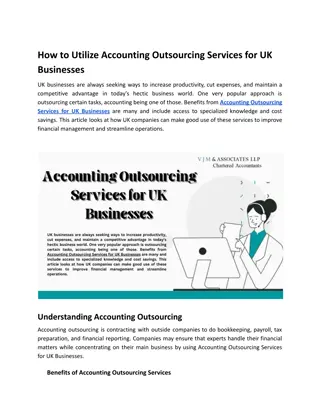Problems with Outsourcing and Covid: Impact on NHS Procurement
The presentation delves into the problems surrounding outsourcing and Covid in the context of NHS procurement, highlighting issues such as cronyism, corruption, cost inefficiencies, delays, and incompetence. It emphasizes the negative consequences of privatization and the need for a more accountable and transparent procurement system within the NHS.
Download Presentation

Please find below an Image/Link to download the presentation.
The content on the website is provided AS IS for your information and personal use only. It may not be sold, licensed, or shared on other websites without obtaining consent from the author. Download presentation by click this link. If you encounter any issues during the download, it is possible that the publisher has removed the file from their server.
E N D
Presentation Transcript
Problems with outsourcing and Covid We Own It webinar 26thNovember 2020 This presentation is based around the report Privatised and Unprepared which was co-authored by David Hall, John Lister, Cat Hobbs, Pascale Robinson, and Chris Jarvis, with additional material from Helen Mercer David Hall Visiting professor PSIRU University of Greenwich halldj@gmail.com
Cronyism and corruption Cronyism and corruption the the NAO report on procurement during COVID pandemic Nov 2020 NAO report on procurement during COVID pandemic Nov 2020 10.5bn awarded directly, no tenders 6.7bn awarded via framework agreements Only 190m (1%) had competitive tender high-priority channel for 493 suppliers selected by ministers/MPs has 10x success Some contracts undocumented, unpublished, back-dated, and redacted This is what corruption looks like, in any country Self-serving behaviour by politicians Corporate strategies to maximise outsourcing, minimize competition and public scrutiny My Little Crony https://sophieehill.shinyapps.io/my-little-crony/
Cost, delay, incompetence as well as corruption Cost, delay, incompetence as well as corruption Multiple failures with the supply of PPE NAO analysis Nov 2020 shows: extraordinary excessive spending, buying too much and 10x prices, no local supplies existing (privatised) stockpile/distribution system (PIPP) fails, for NHS and care homes new parallel system fails (also privatised: Clipper, Tory donor) delays in waiting for for global supply chains, supplier remote Other outsourced NHS work also problematic TTT testing: problems with Deloitte (Cabinet Office minister Chloe Smith ex- Deloitte) TTT tracing: Serco/Sitel only trace 58% of contacts in worst areas ( 730m. Contract) Logistics: outsourced to Unipart, 2000 NHS staff transferred to company, using NHS assets; emergency stockpile (PIPP) to Movianto (was USA owned, now French) Supply chain IT : DXC Technology, despite huge previous NHS IT contract failures: PAC called it in 2014 a rotten company providing a hopeless system
Beyond cronyism: wider NHS system issues Beyond cronyism: wider NHS system issues Privatised and unprepared Privatised and unprepared There are wider systemic issues beyond COVID contract award processes, presented in Privatised and unprepared . 1. Even the 'normal' NHS procurement system in England is a secretive system in which private companies allocate NHS contracts to other private companies, so: by devolving the responsibility for procurement itself, the public interest is not represented in the system in any kind of accountable way. Note govt rejected privatisation of defence procurement in 2013 because of loss of control, corruption potential, and higher costs 2. Fundamental issue is between direct public provision, or outsourcing selection of contractor via procurement is a secondary issue growth of NHS outsourcing is political and corporate over last 35 years
A Complex Web of Contractors: Four Layers of Profit- taking. Awards monopoly/oligopoly contracts Central system prohibits local purchase of items May 2020
The club of 35 strategic suppliers: The club of 35 strategic suppliers : 35 companies designated strategic suppliers Treated as key part of government Each strategic supplier is assigned a crown representative , a civil servant paid by us, to liaise regularly with the company They got 22% of govt contracts in 2019: 15bn named on 288 new framework deals They include 8 outsourcers : Serco, G4S, Amey, Interserve, Engie, Sodexo, ISS, Mitie 4 consultants: Deloitte, PWC, KPMG, E&Y as well as IT, telecoms and construction
The need for public sector capacity for direct provision 1. Problems with NHS dependency on outsourced system of supplies and services The risk of just in time production systems for a public health service the inefficiency of middlemen/global supply chains, cf efficiency of locally responsive production Inflexibility of vested interests with multi-year contracts in centralised system danger of corruption/cronyism, incentive to cut quality, the potential for collapse 2. Need for public sector capacity to deliver service (not pop-up private projects) direct employment of staff to respond and optimize public service objectives efficiency and cheapness of not financing extraction of dividends democratic control and accountability max transparency over use of public money need for democratic (not market) responsiveness to public needs/goods capacity to monitor and supervise any external suppliers
Towards efficient and democratic control Towards efficient and democratic control Start with fundamental direct or outsourced review of all outsourced work Replace strategic suppliers with a strategic direct public sector workforce NHS should re-insource: distribution, stockpiling, TTT, cleaning, catering NHS should ensure local capacity to produce PPE, tests, vaccine, equipment by SMEs and/or by NHS directly: so create NHS manufacturing capacity NHS England should end privatized procurement and reinstate simple non-corrupt public process (as introduced in 1990s) Include full transparency even in Covid (it's cheaper NOT to redact contracts)
No empirical evidence of superior private sector efficiency extensive global empirical evidence on the relative efficiency of the private versus public sectors does not support the view that there is any systematic difference in efficiency between public and private sector companies In the UK especially there is no excuse for such mistaken beliefs, in the wake of a series of fiascos going back to the horrific plunge in NHS hospital hygiene standards after the privatisation of support services in the 1980s, up to more recent examples including the collapse of Carillion, the failure of privatised ambulance and patient transport services, and the incompetence of Compass, G4S, and Serco.
Be like private sector: end outsourcing > inhouse production JCB decide early 2000s to start producing its own engines, not buy in, then make world-record beating own engine - and create 400 jobs in UK: complete control and freedom to innovate cf Boeing outsource design of Dreamliner, disaster, brought huge amounts of work inhouse A growing number of empirical studies find a relationship between the outsourcing of activities and a long term lossof firm productivity growth . large scale outsourcing restricts the scope for future organisational innovation, leading to lower productivity growth. Windrum et al 2009 empirical evidence In contrast to common belief and management practices, extensive out- sourcing of manufacturing activities has a strong negative impact on a firm's profit and total factor productivity (TFP). sub-par product variant and delivery inflexibility of far-shore suppliers or internally disturbed competence formation and value creation processes are in many cases overcompensating the supposed cost benefits of outsourcing. Kinkel et al 2016 backshoring provides higher productivity and flexibility Dachs et al 2017 the 65% decline in R&D productivity appears to stem from substantial reallocation of R&D to outsourced execution, Knott 2020 (USA)
.Even public sector manufacturing? Yes, already .Even public sector manufacturing? Yes, already for vaccines for vaccines successive Tory governments have invested 300m. in public sector capacity for manufacturing vaccines and accelerated under Covid. To be applauded! T May govt invests 66m. in 2018 in new vaccine manufacturer VMIC expanded by Boris: extra 93m. for VMIC to be completed early in March 2021 Invests 38m. in early virtual VMIC capacity , now employing 60 invests 100m in 2nd public sector facility in Braintree, ready Dec 2021
Rebuilding a public and local workforce, lessons from devolution Rebuilding a public and local workforce, lessons from devolution - - local PPE, direct TTT, ban on outsourcing hospital cleaning local PPE, direct TTT, ban on outsourcing hospital cleaning PPE: A number of Scottish firms offered their help and adapted production lines quickly towards the supply of PPE and materials used for PPE manufacture, and between March and August 2020 production was established in Scotland alongside wider UK manufacture. Over the winter period we expect that nearly half of all PPE supplied will be manufactured in Scotland. Scottish Govt Covid PPE action plan Oct 2020 (though this includes Globus firm Alpha Solway, via Arco...) Note also DHSC plan Sept 2020 says hopes for 70% UK mfg of PPE, except gloves. Test, track, trace: NHS Scotland employs 2000+ staff as tracers, not outsourced to Serco et al, Sturgeon claims Test and Protect is working well despite some problems Hospital cleaning insourced: There has been extensive outsourcing of hospital cleaning services in the NHS in England [but] the Scottish, Welsh, and Northern Irish health services have rejected outsourcing of hospital cleaning. In 126 English acute hospital Trusts during 2010-2014, we find that outsourcing cleaning services was associated with greater incidence of MRSA, fewer cleaning staff per hospital bed, worse patient perceptions of cleanliness and staff perceptions of availability of handwashing facilities. However, outsourcing was also associated with lower economic costs . Toffolutti et al 2016
UK has low level of direct public employment by international standards The UK spends less than the EU average on public sector employees but much more than average on purchases from suppliers and contractors. Public expenditure on workers and suppliers, EU & UK 2019 Total govt exp Paybill of public employees Purchases of goods & services % of GDP, 2019 Other EU 28 United Kingdom Germany Spain France Italy Finland Sweden 45.8 41.0 45.4 41.9 55.6 48.7 53.3 49.3 10.0 9.0 7.9 10.8 12.3 9.7 12.3 12.6 5.9 8.1 5.2 5.1 5.0 5.7 11.0 8.0 29.9 23.9 32.3 26.0 38.3 33.3 30.0 28.7 Unlike any other large country, the UK spends almost as much on outsourced supplies as it does on public sector workers. Eurostat Government revenue, expenditure and main aggregates. GOV_10A_MAIN last update: 22/06/2020 https://ec.europa.eu/eurostat/databrowser/view/GOV_10A_MAIN__custom_61854/default/table?lang=en























